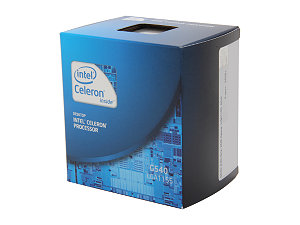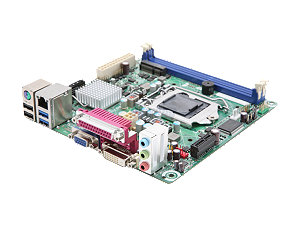Holiday 2012 Small Form Factor Buyer's Guide
by Zach Throckmorton on December 5, 2012 1:55 AM ESTSmall Size, Small Price Tag
While Intel has yet to release Ivy Bridge-based Celeron-class (i.e. cheap) CPUs, I briefly reviewed the Celeron G530's performance in a previous budget buyer's guide. Intel has, however, given its entry-level chips a modest speed bump in that the Celeron G540 and G550 models are often available for a dollar or two more than the G530. Because they are adequate for day-to-day tasks and are priced so low, they remain the kings of the budget CPUs.
 We've paired the Celeron G540 with one of the least expensive ITX Socket 1155 motherboards, Intel's BOXDH61DLB3. While there are less expensive boards, reliability issues prevent us from giving them the nod in this buyer's guide. Intel's entry-level ITX model offers basic features as well as USB 3.0 ports. Note that it does not have a PCIe x16 lane, instead offering a single PCIe x1 lane. This is likely not a concern for a budget, general office productivity box that will likely never need a video card installed but might need a wireless adapter card. Furthermore, its SATA ports are limited to SATA II speeds, so the newest SSDs that use SATA III will be crippled. Again, though, this is a budget system and something has to give. If you need a PCIe x16 lane and SATA III ports, you'll need to step up to a board like ASRock's B75M-ITX or ASUS' P8H77-I.
We've paired the Celeron G540 with one of the least expensive ITX Socket 1155 motherboards, Intel's BOXDH61DLB3. While there are less expensive boards, reliability issues prevent us from giving them the nod in this buyer's guide. Intel's entry-level ITX model offers basic features as well as USB 3.0 ports. Note that it does not have a PCIe x16 lane, instead offering a single PCIe x1 lane. This is likely not a concern for a budget, general office productivity box that will likely never need a video card installed but might need a wireless adapter card. Furthermore, its SATA ports are limited to SATA II speeds, so the newest SSDs that use SATA III will be crippled. Again, though, this is a budget system and something has to give. If you need a PCIe x16 lane and SATA III ports, you'll need to step up to a board like ASRock's B75M-ITX or ASUS' P8H77-I.
Housing the budget build is Apex's MI-008, a longtime favorite of mine for cheap ITX systems. It's reasonably well-constructed, and comes with a serviceable 250W power supply. Its thermals aren't particularly impressive, but for a system lacking a discrete graphics card and running a Sandy Bridge Celeron, it doesn't need to have the best airflow. The MI-008 can accommodate full size hard and optical drives, which helps keep costs down.
 As for the memory, a single 4GB stick of budget DDR3-1333MHz is sufficient for basic computing in Windows 7 64-bit (or Windows 8 if you want to go that route), and leaves an open slot so upgrading to 4GB in the future will be cheap and easy. Hard drive and solid state drive prices are especially dynamic this time of year, making recommendations difficult. While day to day hard drive prices remain elevated in the wake of the notorious Thailand floods, sale prices are beginning to get back to where they were before hard drive supplies were disrupted late last year. If you're patient and pay attention to prices, you will likely be able to snag a mainstream 7200RPM 1TB hard drive for $60 or less. If you don't need much local storage, a 64GB SSD will give you an enormous performance boost for about the same price.
As for the memory, a single 4GB stick of budget DDR3-1333MHz is sufficient for basic computing in Windows 7 64-bit (or Windows 8 if you want to go that route), and leaves an open slot so upgrading to 4GB in the future will be cheap and easy. Hard drive and solid state drive prices are especially dynamic this time of year, making recommendations difficult. While day to day hard drive prices remain elevated in the wake of the notorious Thailand floods, sale prices are beginning to get back to where they were before hard drive supplies were disrupted late last year. If you're patient and pay attention to prices, you will likely be able to snag a mainstream 7200RPM 1TB hard drive for $60 or less. If you don't need much local storage, a 64GB SSD will give you an enormous performance boost for about the same price.
While Windows 7 64-bit remains the de facto standard operating system for PCs, note that Windows 8 64-bit is now also available. Note that for this budget build, the $92 Windows license accounts for about 25% of the total cost. If you're on an extremely tight budget, or simply want to explore other operating systems, be sure to check out a free OS like Ubuntu.
| Component | Product | Price |
| Case | Apex MI-008 | $48 |
| Power supply | (included with case) | |
| CPU | Intel Celeron G540 2.5GHz dual-core | $45 |
| Motherboard | Intel BOXDH61DLB3 mITX | $72 |
| RAM | G.Skill Value 4GB DDR3-1333MHz | $18 |
| Hard drive | Seagate Barracuda 1TB ST1000DM003 | $70 |
| SSD alternate | Intel 330 Series 60GB | $70 |
| Optical drive | Samsung SH-224BB DVD burner | $16 |
| Operating system | Windows 7 64-bit Home Premium OEM | $92 |
| Total: | $361 |
Check the next page for our small form factor file server build.










74 Comments
View All Comments
96redformula - Wednesday, December 5, 2012 - link
Not sure how you couldn't include Silverstone SG-09 as a case. Yeah, I know, the style is hit or miss, but hard to argue vs all the capabilities and features of it.I have a full blown gaming system in mine and the advantages are huge; the option of going crossfire/SLI, full sized CPU tower, water cooling capable, and smaller than the Bitfenix Prodigy case.
bim27142 - Wednesday, December 5, 2012 - link
it's more expensive i think that's why...JohnMD1022 - Wednesday, December 5, 2012 - link
Requires a slot load optical drive... $70. Waiting for mine to arrive.Needs the special ODD cable ($9).
For all intents and purposes, requires a Silverstone full modular power supply ($80 and up) plus the short cable set ($25).
We're over $100 already, plus the $100 for the case.
Hmmmmmmmmm...
lmcd - Sunday, January 13, 2013 - link
Brief correction: slot-load dvd is $30JohnMD1022 - Saturday, February 9, 2013 - link
$30?Where?
Half height tray loads are $30.
Slot loads are 70+
:)
Cygni - Wednesday, December 5, 2012 - link
These tiny ITX systems also have another use not really mentioned: as a full blown media center PC (often with CableCard tuners). It's a combo of features that's hard to nail right now in the market place... quiet, small, presentable in the middle of a living room, optical audio out, half height PCie bracket you dont have to bend to get to work, etc.I currently have a G530, BIOSTAR TH61ITX, and Antec ISK 310-150, with a Ceton 4 tuner card. Looking pretty hard at going to a 35w Ivy Bridge Celly/Pentium when they become available, because even the dainty G530 is enough to spin up the fans with 3 channels recording.
pdffs - Wednesday, December 5, 2012 - link
I was thinking this too, but...Optical audio should pretty much be phased out now that HDMI is so prevalent (HDMI audio is vastly superior, and carried by all equipment for the past few years).
And it'd be hard to recommend a capture card for such a build, since there are so many standards in different regions.
I'm looking at replacing my aging ION box with some Ivy Bridge (though I wish Intel would fix the 24p frame-rate issue).
Rick83 - Wednesday, December 5, 2012 - link
I disagree: The stereo amplifier I bought two years ago features optical in, but no HDMI.Optical also means less conducitivity, so more resilience against interference.
Optical cables are much thinner. I run one under a door, where it is all but invisible, an HDMI cable would be a huge eye-sore - and would not fit.
HDMI audio may be somewhat superior, if you have sources that get you "HD" codecs, but those are only on BDs anyway, so no point for most of us, who can't be bothered with BDs due to the DRM breaking free players - and just use a stand alone device.
Music, games and everything else wil mostly be fine with optical. While multichannel PCM is nice to have, you'll need support on both ends, to gain anything over DTS/DD encoded audio.
Plus, you don't always want to logically bind display and audio together.
And then there's display port, which I'd prefer over HDMI.
erple2 - Thursday, December 6, 2012 - link
<quote>less conducitivity, so more resilience against interference.</quote>What? HDMI is a digital signal, which means it either works or doesn't, much like how an HDMI video signal is NOT affected by the 'quality' of the cables. Unless you're talking about something else.
Bender316 - Thursday, December 6, 2012 - link
HDMI IS copper cable, and the signal is just voltage on that cable - whether Analogue or Digital, neither are totally immune to interference. So there are limitations and are potential interference issues.If you want a very long distance (cabling through doorways is mentioned) - I believe the Low-Voltage Differential Signal standard it uses recommends max 15m? I'd have to check. At the same time the LVDS signalling is very robust, and should be fairly good at dealing with interference.
Optical on the other hand is light in a glass tube. Electromagnetic interference should not be an issue. Distance obviously impacted by the driver, but I seem to recall max distances are a lot higher than HDMI.